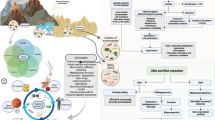Abstract:
Free energy calculations and experimental measurements have been used to show that H2S/CO2 mixtures outgassing from a prebiotic Earth's crust would have produced a reducing gas mixture containing CO, H2, H2O, and S x as principal components. Due to rapid recombination of H2, CO, and S x to H2S and CO2 on cooling from a high temperature to ambient conditions, reducing components would have been retained only if efficient quenching of the reduced gas mixture had been possible. Consequently, subsea vents or vents with efficient infusion of water would have been ideal sites for retention of reduced species and for prebiotic organic synthesis. It is suggested that C/H/O/S ratios are important factors in controlling the degree of prebiotic organic synthesis and, hence, the emergence of life, since if oxygen is abundant, CO2 and SO2 would have been dominant species.
Similar content being viewed by others
Author information
Authors and Affiliations
Additional information
Received: 5 March 1997 / Accepted: 15 December 1997
Rights and permissions
About this article
Cite this article
Clark, P., Dowling, N. & Huang, M. Comments on the Role of H2S in the Chemistry of Earth's Early Atmosphere and in Prebiotic Synthesis. J Mol Evol 47, 127–132 (1998). https://doi.org/10.1007/PL00006369
Issue Date:
DOI: https://doi.org/10.1007/PL00006369




